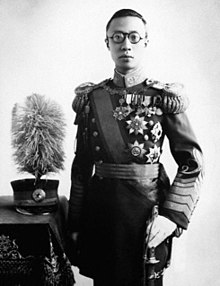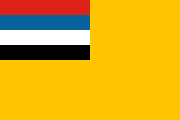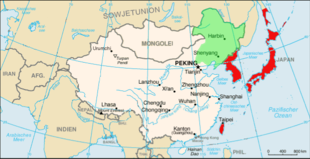Manchukuo
|
滿洲 國 (Mǎnzhōu Guó) ( Chinese ) 滿洲 國 (Manshū koku) ( Japanese ) ᠮᠠᠨᠵᡠ ᡤᡠᡵᡠᠨ(Manchu Gurun) ( Manchurian ) |
|||||
| Manchu State | |||||
| 1932-1945 | |||||
|
|||||
| Official language | Japanese , Manchurian , Mongolian , de facto also Mandarin | ||||
| Capital | Xīnjīng / Shinkyō (新 京, today again Changchun ) | ||||
| Form of government | monarchy | ||||
| Head of state | Kāngdé ( Puyi ) (1932–1945) | ||||
| Head of government |
Zheng Xiaoxu (1932-1935) Zhang Jinghui (1935-1945) |
||||
| surface | approx. 800,000 km² | ||||
| population | 1937: 38 million | ||||
| currency | 1 gen (元) = 100 bun (分) | ||||
| founding | March 1, 1932 | ||||
| resolution | August 18, 1945 | ||||
| National anthem |
National anthem of Manchukuo (last version from 1942) |
||||
Manchukuo , also Manchuko ( Manchurian ᠮᠠᠨᠵᡠ
ᡤᡠᡵᡠᠨ, Manchu Gurun , Chinese 滿洲 國 / 满洲 国 , Pinyin Mǎnzhōuguó , W.-G. Man-chou-kuo ; Japanese 満 州 国 Manshūkoku , German “State of Manchu, Manchurian” ) or Manshū teikoku ( 滿洲 帝國 / 满洲 帝国 , Mǎnzhōu Dìguó , Japanese 満 洲 帝国 , German “Kaiserreich Manschu” ), was an “Empire” established by Japan in Manchuria . It existed from March 1, 1932 to August 18, 1945, but was only recognized by 23 countries internationally. Puyi , who as a toddler from 1908 to 1912 was formally the last emperor of China, was installed as ruler ; 1932 first as President and from 1934 Emperor of Manchukuo. It is now part of the People's Republic of China . Many historians see Manchukuo as a puppet state .
development
prehistory
The Empire of Japan had after the First Sino-Japanese War Korea won as sphere of influence and interest in the natural resources from Manchuria. Due to the occupation of this area by Russia until 1900, Japan saw its plans disturbed. After the Japanese ambassador in 1903 unsuccessfully demanded the withdrawal of Russian troops from Manchuria and the recognition of Japanese interests in Korea , the steadily growing tensions finally culminated in the Russo-Japanese War in 1904 . Japan won it and Russia had to evacuate Manchuria, which was officially returned to China.
However, Japan secured great influence and built the South Manchurian Railway to bring raw materials from Manchuria to Korea and ship them to Japan from there. The railway was protected by the Japanese Kwantung Army . After the Great Depression, many Japanese military saw a solution to their problems through further expansion towards Manchuria.
Manchuria enjoyed de facto independence from China between 1916 and 1928 under the warlord Zhang Zuolin . However, Zhang was killed in a bomb attack by the commander of the Kwantung army, Colonel Kōmoto Daisaku , and Manchuria was recaptured by the Kuomintang under Chiang Kai-shek , who had been waging a war against Zhang in the northern expedition since 1926.
Occupation and foundation

After the Mukden incident staged by Japan on September 18, 1931, the Manchuria crisis broke out and the Kwantung army occupied Manchuria without much consultation with the Japanese government. Under Japanese influence, local notables declared independence on February 18, 1932 . This occupation was condemned by the US through the Hoover-Stimson Doctrine and the League of Nations protested. In 1933 the Chinese province of Jehol , which is not part of actual Manchuria, was annexed to the new state.
Japan tried to bind the area culturally and to exploit it economically. The Japanese language became the official language and Shinto became the official state religion. With the Eintrachtverband , a future state-supporting party should be built. The economy and infrastructure were massively expanded.
Unit 731 of the Japanese Army was also stationed in Manchukuo, conducting research on biological and chemical weapons and conducting human experiments.
Between 1932 and 1939 there were various border conflicts between the Soviet Union and Japan , when Japan tried to extend the border of Manchuria to include Soviet territory or Mongolia, which is under Soviet influence. In 1939 the Nomonhan incident occurred on the border between Manchukuo and Mongolia, which developed from several border skirmishes to the battle on the Chalchin Gol river . The fighting between Soviet troops led by General Georgi Zhukov and the Mongolian Revolutionary People's Army on the one hand and Manchurian and Japanese troops on the other ended in the crushing defeat of the Japanese 6th Army. On September 16, 1939, an armistice agreement with the Soviet Union put an end to the border conflicts. In the period that followed, the Japanese instead expanded their sphere of influence towards Southeast Asia.
World War II and end of the state
During the Second World War , Manchukuo, like Japan, belonged to the Axis powers . Up until mid-1945 there was practically no fighting in Manchukuo's territory, since the Japanese Empire and the Soviet Union signed the Japanese-Soviet Neutrality Pact on April 13, 1941 ( Japanese 日 ソ 中立 条約 nisso chūritsu jōyaku ; Russian Пакт о нейтралитете межн ) on closed for five years.
At the Yalta Conference in February 1945, at Roosevelt's insistence, Stalin undertook to start the war in the Far East and attack Japan and its allies 90 days after the end of the war in Europe, in breach of the neutrality pact. The Red Army kept the deadline to the day. From August 8, 1945, Manchukuo was occupied by Soviet troops in Operation Auguststurm and returned to the Republic of China in 1946 in accordance with the Allied war goals from the Cairo Declaration .
Contrary to the expectations of the Western Allies, the national Chinese government under Chiang Kai-shek did not succeed in gaining control of Manchuria despite massive financial support. With the help of the Soviet Union, the Chinese communists built Manchuria into their power base. The continuation of the Chinese civil war and, ultimately, the victory of the Chinese communists are therefore closely related to the temporary Soviet occupation.
International recognition
Only 23 of the then 80 countries in the world recognized Manchukuo under international law or diplomatically. The League of Nations declared that Manchukuo was and will remain part of the Republic of China under international law. According to the report of the Lytton Commission, this led to Japan's withdrawal from the League of Nations on March 27, 1933. Manchukuo was diplomatically recognized by the following states and governments:
- Japan , from September 16, 1932
- El Salvador , from March 3, 1934
- Vatican City , de facto recognition from April 18, 1934
- Kingdom of Italy , from November 29, 1937
- Spain , from December 2, 1937
- German Empire , from May 12, 1938
- Hungary , from January 9, 1939
- Mengjiang (Puppet State of Japan), from September 1939
- Poland , de facto recognition from October 19, 1939, withdrawn in 1942, both by the Polish government in exile
- Slovakia , from June 1, 1940
- Vichy France
- Denmark , from August 1940
- Nanjing Government of China , from November 30, 1940
- Romania , from December 1, 1940
- Dominican Republic
- Soviet Union , indirect recognition by the Japanese-Soviet Neutrality Pact on April 13, 1941
- Mongolian People's Republic , indirect recognition on April 13, 1941
- Bulgaria , from May 10, 1941
- Finland , from July 18, 1941
- Croatia , from August 2, 1941
- Thailand , from August 5, 1941
- Burma , from August 1943
- Philippines , from October 1943
As the 24th diplomatic recognition and no end in October 1943 came the Japanese puppet government in exile in India , based in Singapore add a "government" that although the Japanese occupied on paper Andaman and Nicobar Islands were put under, but in fact no state authority exercised.
population
The population in 1937 consisted for the most part of around 35.5 million Manchu and Chinese . Japan tried to settle more Japanese and especially Japanese farmers in the region , but this did not succeed because the standard of living in Manchukuo was lower and Japanese agricultural techniques were not suitable for the conditions in Manchuria. Between 1931 and 1937, only 417,759 Japanese settled in Manchukuo. Therefore, with the immigration plan One Million Families in 20 Years, a government funding of 1,060 yen was decided. The Japanese families should be settled especially in the poorly developed regions in the east and north. The Manchurian Development Company, founded in 1938, undertook a training program for Japanese people between the ages of 16 and 19 to adapt them to life in Manchuria. About 19,000 Japanese were trained in the program. The Japanese also tried to settle Koreans in Manchuria.
economy
Banks and economic bodies were under tight control of the Japanese.
Japan invested around 5.2 billion yen in Manchukuo between 1932 and 1942, an unusually large amount for colonial investments compared to European or American colonies. The infrastructure and the cities were massively expanded and modernized. The industrialization was promoted. In Manchukuo, Japan experimented with high-speed trains for the first time , as the Japanese rails were not suitable for this because of their narrow-gauge construction. The Ajia operated by the South Manchurian Railway drove a top speed of 120 km / h between Dairen and Xinjing / Shinkyō from 1934 and was fully air-conditioned. Manchukuo also owned a national airline , the Manchuria Aviation Company .
Most of the economy consisted of agriculture , which was state controlled. More than half of all exports - 65 percent in 1936 - made up beans , especially soybeans , and bean products. In 1936, 85 percent of exports were agricultural products.
Another important branch of the economy was the mining of raw materials, especially ores and coal , the export share was 11 percent in 1936.
The heavy and mining industries were under the control of the South Manchurian Railway Company , or SME for short . In addition, most of the investments and money transfers were organized and managed by the SME. This led to a power struggle with the Guangdong Army, which finally established a monopoly on heavy industry together with Nissan in 1937, thus removing this sector from the SME. Between 1932 and 1936, monopoly firms were set up that monopolized certain sectors , including the Manchurian Bank and Manchukuo National Airways .
Japan, on the other hand, exported heavy industrial products in particular to Manchukuo.
See also
- Pacification of Manchukuo
- Japanese colonies
- Army of the Manchurian Empire
- Navy of the Manchurian Empire
- Air forces of the Manchurian Empire
literature
- Jasper Wieck: Path to »Décadence«. France and the Manchurian crisis 1931–1933 (= Paris Historical Studies. 40). Bouvier, Bonn 1995, ISBN 3-416-02554-7 ( digitized version )
Web links
Remarks
- ↑ a b Elizabeth Boody Schumpeter (Ed.): The Industrialization of Japan and Manchukuo, 1930-1940. Routledge, o. O. 2000, ISBN 0-415-21823-3 , p. 68 ff.
- ^ Area and population of Manchuria. : Notifications of the Imperial (-) Royal Geographical Society / Notifications of the Imperial and Royal Geographical Society in Vienna / Notifications of the KK Geographical Society in Vienna / Notifications of the Geographical Society in Vienna / Notifications of the Geographical Society Vienna in of the German Geographical Society. Organ of the German Geographical Society for the European Southeast , year 1932, p. 303 (online at ANNO ).
- ^ Norman Kolmar, Thomas B. Allen: Spy Book - The Encyclopedia of Espionage. Greenhill Books, London 1997; ISBN 1-85367-278-5 (English), here: Entry about Doihara Kenji
- ^ Institute for Contemporary History i. A. of the Foreign Office: files on the foreign policy of the Federal Republic of Germany. Oldenbourg, 1971, ISBN 3-486-56618-0 , p. 53.
- ↑ a b c d Christopher B. Howe: The Origins of Japanese Trade Supremacy. C. Hurst & Co., 1999, ISBN 1-85065-538-3 , p. 398 ff.
- ^ Louise Young: Japan's Total Empire. Manchuria and the Culture of Wartime Imperialism (= Twentieth Century Japan: The Emergence of a World Power. Volume 8). University of California Press, Berkeley 1999, ISBN 0-520-21934-1 , pp. 183 ff. ( Limited preview in Google book search).
- ↑ Elizabeth Boody Schumpeter (Ed.): The Industrialization of Japan and Manchukuo, 1930-1940. Routledge, o. O. 2000, ISBN 0-415-21823-3 , p. 303 ff.
- ↑ a b Takafusa Nakamura, Konosuke Odaka (ed.): Economic History of Japan 1914–1955. Oxford University Press, Oxford 2003, ISBN 0-19-828907-3 , p. 49 ff.






